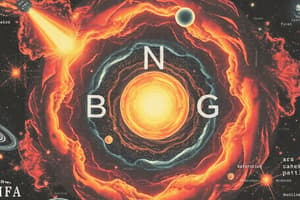Podcast
Questions and Answers
Which theory explains the early universe as a rapidly expanding bubble of pure vacuum energy?
Which theory explains the early universe as a rapidly expanding bubble of pure vacuum energy?
- Steady State Theory
- Nebular Hypothesis
- Cosmic Inflation Theory (correct)
- Big Bang Theory
What does the term 'red shift' refer to in the context of the universe?
What does the term 'red shift' refer to in the context of the universe?
- The observation that more distant objects in the universe have larger wavelengths (correct)
- The discovery of new planets
- Observations indicating stars shifting to shorter wavelengths
- A theory about cosmic dust
Which layer of the Earth is immediately above the asthenosphere?
Which layer of the Earth is immediately above the asthenosphere?
- Lithosphere (correct)
- Core
- Moho
- Mantle
What primarily composes the Earth's core?
What primarily composes the Earth's core?
What is the Mohorovicic Discontinuity commonly referred to as?
What is the Mohorovicic Discontinuity commonly referred to as?
What does the Nebular Hypothesis explain?
What does the Nebular Hypothesis explain?
Which scientist is credited with explaining that distant objects had larger redshifts?
Which scientist is credited with explaining that distant objects had larger redshifts?
What distinguishes the inner core from the outer core in Earth's internal structure?
What distinguishes the inner core from the outer core in Earth's internal structure?
Flashcards are hidden until you start studying
Study Notes
Formation of the Universe
- Big Bang Theory indicates the universe began as a hot, small entity and expanded explosively approximately 13.7 billion years ago.
- Red shift phenomena show distant galaxies moving away, supporting the idea of an expanding universe.
- Steady State Theory posits that the universe maintains constant average density while expanding.
- Cosmic Inflation Theory suggests rapid expansion of the universe occurred in its early stages due to pure vacuum energy.
- Edwin Hubble demonstrated that the farther away a galaxy is, the faster it is receding, providing evidence for cosmic expansion.
Formation of the Star Systems
- Nebular Hypothesis is the prevailing model explaining how the solar system formed and evolved from a cloud of gas and dust.
- Planetesimal and Tidal Series theory asserts that planets revolve in the same direction, with inner planets possessing greater density than outer ones.
- William Huggins discovered that stellar light emitted is often shifted to longer wavelengths, reinforcing the concept of redshift.
Earth's Internal Structure
- Crust comprises oceanic and continental layers, with thickness ranging from 5 to 70 km.
- Mohorovicic Discontinuity (Moho) separates the crust from the underlying mantle, marking a significant transition.
- Mantle lies beneath the crust and is divided into several sub-layers.
- Asthenosphere is a sub-layer of the mantle, serving as the source of magma that rises through the crust.
- Lithosphere encompasses the solid outer layer of Earth, including both the crust and the upper mantle.
- Gutenberg Discontinuity is the boundary separating the lower mantle from the outer core.
- Core primarily consists of iron and nickel, representing the innermost layer of the Earth.
- Lehman Discontinuity identifies the transition between the outer core and the inner core.
Studying That Suits You
Use AI to generate personalized quizzes and flashcards to suit your learning preferences.




